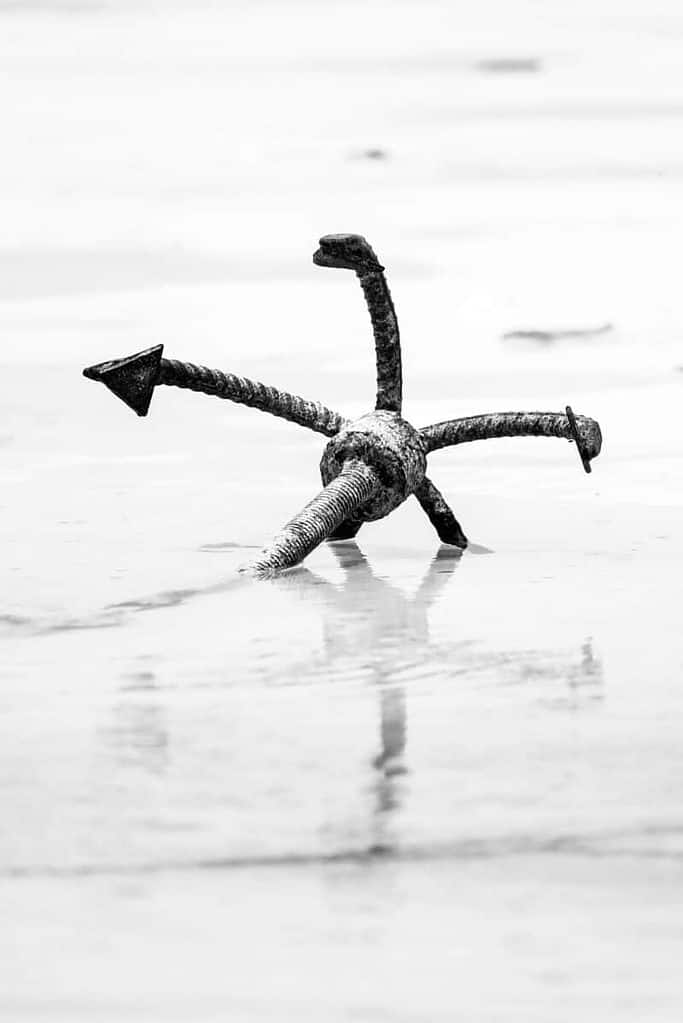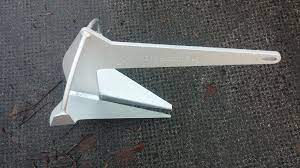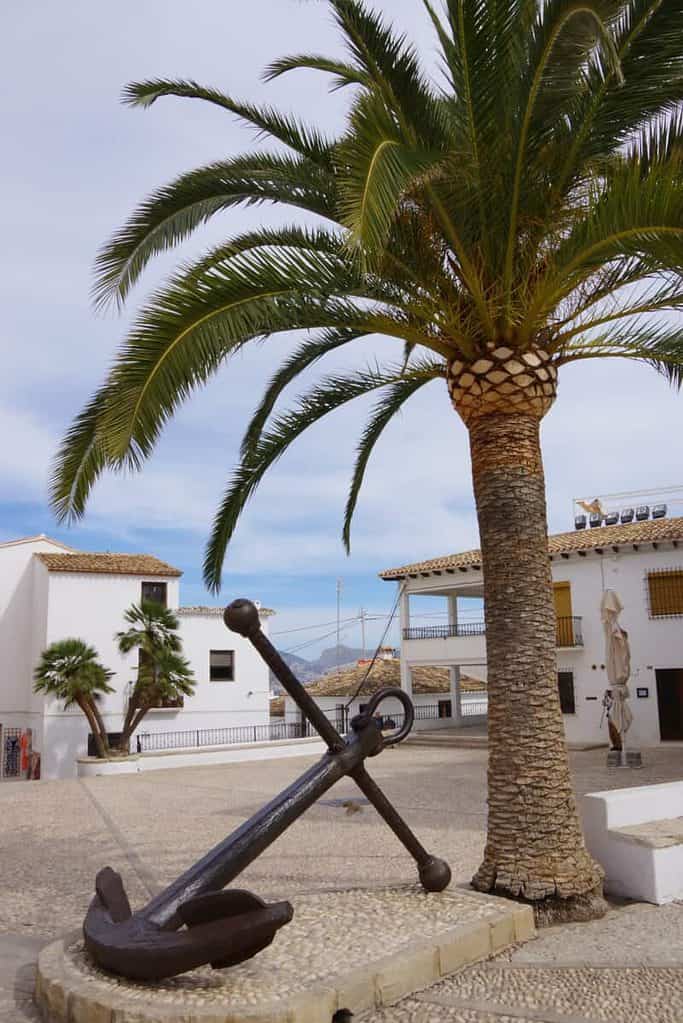
What is the Best Type of Anchor?
Boaters frequently ask, what is the best type of anchor for their boat and the answer is often “more than one anchor, of different types.” The type of bottom conditions —mud, grass, sand, or rock—will dictate different choices of anchors, as will the size and windage of the boat, the wind conditions, and the state of the water.
The best way to determine the right anchor for your boat is based on:
- Bottom conditions – Holding power and weight are only as good as the anchor’s ability to penetrate the bottom. As for shape, it depends on the sea bottom type.
- Anchors can be divided into four big groups: grapnels, plough anchors, box anchors, and patent anchors – stock anchors.
- Holding Power – It is best to choose an anchor based on the weight of the boat we will explore this in the table below …
- Weight – Bigger is better when choosing anchor weight. But also to consider are chain size and shape of the anchor
Anchors can be divided into four big groups: grapnels, plough anchors, box anchor, patent anchors – stock anchors, let’s explore each one of these:

What is a grapnel anchor?
A grapnel anchor is a traditional design. The grapnel is simply a shank with four or more prongs. It has a benefit in that no matter how it reaches the bottom, one or more prongs will be positioned to set. In coral it can often set quickly by hooking into the structure, but may be more difficult to retrieve. These are normally used to anchor a smaller boats
What is a grapnel anchor used for?
A Grapnel anchor is generally used for small boats such as Kayaks, Dinghies, Canoes, Pwc etc. It’s also popular with fishermen. They fold up very compactly and are easy to stow. A Grapnel’s holding power comes from hooking onto another object, such as a rock.
Do grapnel anchors work?
In currents or winds, grapnel anchors work when the arms dig into the bottom or catch on debris on the bottom. The biggest fear is that it may actually get so stuck that you may have to cut the rope.
What type of anchor is best for sand?
fluke anchors, The anchor arm, buries itself after the pointed flukes dig into the bottom. For those reasons, fluke anchors are best in hard sand and mud. The flukes can’t penetrate rocky bottoms and are not recommended for slick, grassy bottoms. Loose mud or clay can also be challenging for the flukes and prevent bottom penetration.
What are plough anchors?

Plough anchors feature a single-point style and are generally hold more effectively in grass, mud, and sand since they plough into the substrate of the seafloor. This giving them the name of plow anchor. They are designed for heavier vessels, which is why they are commonly used as primary anchors by heavier powerboats and cruising sailboats as well a private boaters. They generally work well in all bottoms, but are not exceptional in any of them.
What anchor is good for most boats?

Plow-Style Anchor: This anchor is good for most boats and gets its holding power by plowing into bottom sediment. Fluke-Style Anchor: This anchor (commonly referred to as Danforth) is similar to the plow style but is more lightweight.
What is an Anchor Box anchor?
The Box Anchor is designed to do all the work for you. Just kill the engine and toss the anchor overboard; it’s that easy. The Box Anchor will hit the bottom, roll to its side, and set within one foot with no need to power down.
The Box Anchor is a state of the art offshore anchor that brings anchoring to a new level of sophistication, allowing you to have more control over the placement of your boat in any situation, regardless of the current and bottom condition. The Box Anchor is designed to work with almost any boat size, from personal watercrafts to houseboats and most everything in between.
The Box Anchoring system is designed for boats of all sizes and in any type water. It requires no lead chain and only 1/2 the anchor line of conventional anchors. Sets quickly in almost any bottom condition, retrieves easily and folds flat for storage. Box anchor sets on any side it falls due to its fixed scoop design and narrow side panels.
https://www.slideanchor.com/boxanchor
What is the Slide Anchor Shore Spike?
The Slide Anchor Shore Spike gives you all the holding power you could ever need on shore. Nothing gives you more peace of mind on the water than knowing that your boat is secure, and the Shore Spike does just that.
The Slide Anchor Shore Spike provides a shore tie anywhere you might want to beach your boat, offering a tremendous amount of driving power to break through even the toughest ground conditions and enough holding power to secure your boat in the softest of sands or strongest of winds.
To start, simply drive the tubular handle downward to deliver the spike blade into the shoreline. Once the Spike is secure, just tie it off to the lower ring. Retrieval is just as easy: just tap the tubular handle upward to free the Spike from the shoreline.
The Slide Anchor Shore Spike is designed to be used in shallow water as well as on the shore. The top is open for air, water, and debris to pass freely through the handle allowing easy operation underwater. A top ring is provided for a buoy to mark the location of your Spike for other boaters and foot traffic.

What is a Patent Anchor?
A stockless anchor (or “patent anchor”) is a streamlined derivation of the traditional Admiralty anchor used aboard large ships. Patented in England in 1821, it eliminated the stock of the Admiralty, making it both easier to handle and stow.
What is a stockless anchor used for?
A stockless ship anchor is designed for ships that may encounter all types of sea bottoms, as they have the advantage of a dead weight for holding in very hard bottoms, and the ability to bite and hold in sand and/or mud. Stockless anchors are rugged in construction and simple in design making them easy to handle.
What is stock and stockless anchor?

The crown, arms, and flukes of a stockless anchor are cast in one piece and can pivot slightly from side to side on the shank. The flukes are long and heavy, and have projecting shoulders at their base that catch on the seabed. As more drag is placed on the anchor, the shoulders force the flukes downward into the bottom.
What is the disadvantage of stockless anchor?
The disadvantage of the stockless anchor is that they have been shown to perform poorly in soft cohesive bottoms such as soil or sand compared to other anchor types made specifically for that type of bottom.
Anchor Weight and Rode Guide
What is a rode on an anchor?
An anchor-rode is the connection between the anchor and the boat and its sturdiness during mooring. The critical point is the splice where the rope and chain are connected.
Reference the charts below for the correct anchor weight and rode:
Anchor Weight Guide
| Boat Size | Anchor Weight | |||||
| Length (ft) | Weight (lb) | Bruce (lb) | Danforth* (lb) | Fortress (lb) | Plow (lb) | Yachtsman (lb) |
| 20 – 25 | 2,500 | 4.4 | 8-S, 5-H | 4 | 10 | 15 |
| 26 – 30 | 5,000 | 11 | 13-S, 12-H | 7 | 15 | 25 |
| 31 – 35 | 10,000 | 11/16.5 | 22-S, 12-H | 7/10 | 20 | 35 – 40 |
| 36 – 40 | 15,000 | 16.5 | 22-S, 20-H | 10 | 25 | 50 |
| 41- 45 | 20,000 | 22 | 40-S, 20-H | 15 | 35 | 65 |
| 46 – 50 | 30,000 | 22/44 | 65-S, 35-H | 21 | 45 | 75 |
| 51 – 60 | 50,000 | 44 | 85-S, 60-H | 32 | 60 | 100 |
*Danforth is a registered trademark. Similar-style anchors may differ significantly in performance
Anchor Rode Guide
| Boat Size | Anchor Rode | |||
| Length (ft) | Weight (lb) | Chain (dia.-inch) | Nylon (dia. -inch) | Length (ft.) |
| 20 – 25 | 2,500 | 3/16 | 7/16 | 90 |
| 26 – 30 | 5,000 | 1/4 | 7/16 | 135 |
| 31 – 35 | 10,000 | 5/16 | 1/2 | 190 |
| 36 – 40 | 15,000 | 3/8 | 9/16 | 225 |
| 41- 45 | 20,000 | 7/16 | 5/8 | 240 |
| 46 – 50 | 30,000 | 1/2 | 11/16 | 315 |
| 51 – 60 | 50,000 | 9/16 | 3/4 | 360 |
How to determine the length of the anchor line?
To obtain maximum holding power of your anchor, the total anchor rode should be 4 to 7 times the depth of the water you will be anchoring in.
A good anchor system is to have a short length of chain (6′-30′) connected to the anchor, with a long length of three-strand nylon line connected to the chain. This combination satisfies nearly all requirements of a good anchor rode. Nylon is preferred for its elasticity, the stretch reduces peak loads on the anchor and on your boat. The primary function of the chain connecting the anchor to the rope is to handle the chafe from rough bottoms that would otherwise damage the nylon rope.
What size chain do I need for my boat anchor?
There are 3 main sizes in anchor chain: 1/4 inch for smaller inshore boats, 5/16 inch for mid-size boats, and 3/8 inch for larger offshore boats. The standard rule of thumb is 1 foot of chain per foot of boat.
What should be the size and length of the anchor line and chain?
Determining how long your anchor rode should be, is to use a good rule of thumb which is that the length of the line should be at least seven to ten times the depth of the water where you are setting anchor in. As for rope size, the rule of thumb is 1/8″ of rope diameter for every 9′ of boat length. Be sure the anchor line is strong and long enough to anchor your boat.

